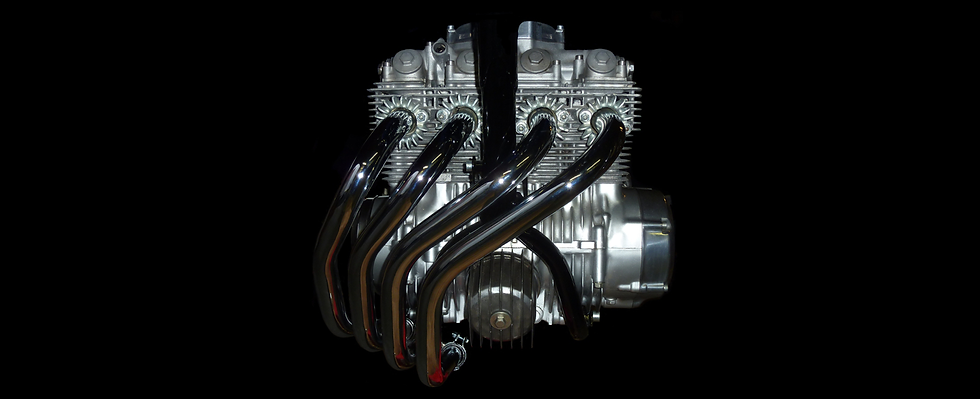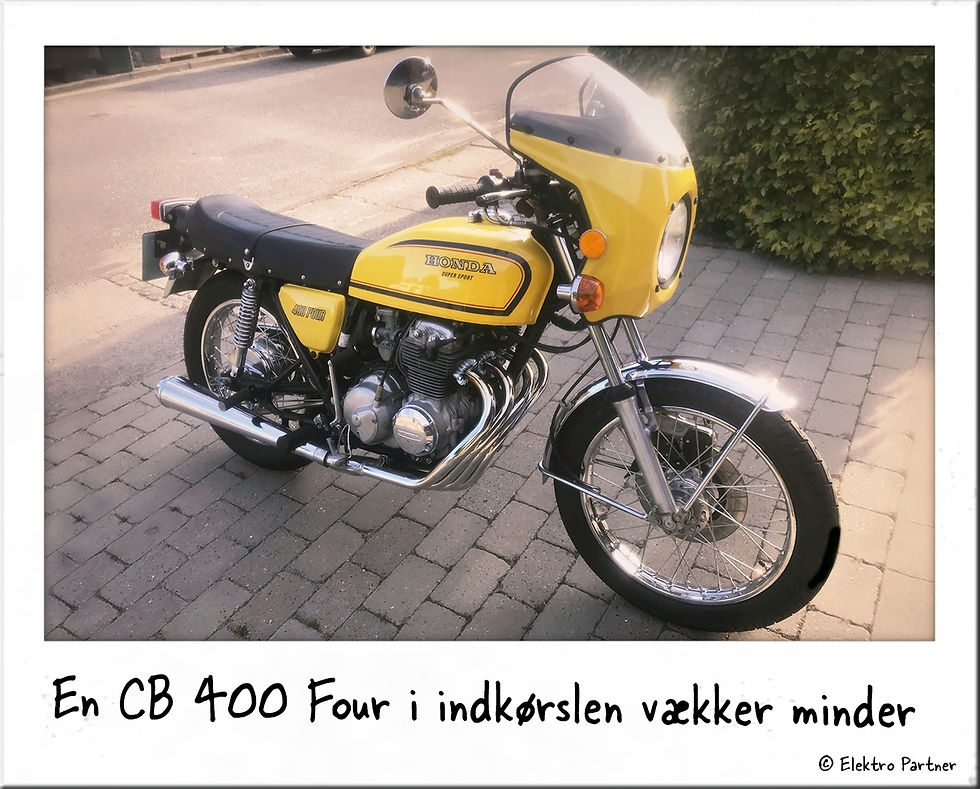The lady decides - MY LUCK
- Frank Donslund
- Feb 17, 2021
- 4 min read


My Honda CB 400 is from 1977, and it had driven a good 14,000 km when I found it. A caring owner! He had driven the distance shown on the odometer over a period of a few years and then set it aside. The many years away from the road meant that time had passed over it almost without a trace.
The wife decides, my luck
It stood for a number of years in a heated room at a nursery. It was dusty, but completely free of rust and corrosion. The story was that when the owner got married, the wife didn't want him to ride the motorcycle anymore. But as he said: "I couldn't bring myself to sell". But now he had fallen ill, and the nursery has to be sold, and therefore it had to go.
A friend of the house had to arrange for it to be sold, and it appears in my universe out of the blue. It happens in the winter of 2015. A short time before I had started to restore a worn and rusty copy. I choose to stop my renovation project and buy this yellow beauty. I therefore have a dismantled CB 400 lying in the attic, waiting for better times.
After 30 years of inactivity, a lot had to be done to bring it back to life. A new battery and it could start, but it would not idle and would not go on gas. The wheels had also become crooked from standing. The carburetors had to be removed and ultrasonically cleaned, the idle jets were blocked and had to be replaced. Unfortunately, the owner had a penchant for stickers - they had burned into the paint, so the side covers and fairing had to be repainted. I left the period-typical hood, which houses a few extra instruments, as well as the control box for a home-made electronic ignition system. But all other equipment came off, such as the luggage carrier, roll bar, oil cooler and steering damper. The wheels were refurbished and it got new tyres. Everything original that was peeled off came with it in a cardboard box, including all original documents and its service book.
After a round of oil and filters, it was ready to hit the roads again in the summer of 2016. I enjoy airing it on warm summer days. It has just completed 15,000 km.
A true world champion

Honda is world champion in small motorcycles with 4-stroke engines in the 70s. They had a full program from 90-1000 cubic meters. When Honda launched their CB 400 Four in 1974 it was a masterpiece. A small and light motorcycle that drove as well as it looked. Many of my generation started motorcycling life with a Honda 400.
Many who bought the CB 400 had had a Honda CD 50 and liked the 4-stroke. The choice was also quite easy, because it looked like a superbike, and the 4 cylinders and the cheeky exhaust pipe with the nicely curved pipes over the oil filter gave respect at an affordable price. In fact, the 2 cylinder Honda models became almost unsellable overnight, all had to have 4 cylinders during that period. The Honda CB 400 Four was also the first motorcycle from Honda, which was built with particular consideration for the tastes of European motorcyclists. Many of them were also sold. Production reached over 100,000 in the period from 1974-1978. The engine was refined and extremely quiet. With the 37 hp, it was not pushed very hard, and it could be driven over long distances with the gas at the bottom without protests from that side. With a little good will it could reach 160 km/h, and the sound from the engine above 6000 rpm was not reminiscent of anything of just 400 cubic meters - it was the sound of a thoroughbred machine. 4 in 1 exhaust was something new on a standard machine, with a very special sound as a result. Due to a fine gear change with as many as 6 gears, it could also be kept on the boil on curvy roads, where it was at its best. The suitably forward-bent driving position, with slightly moved back, high-placed footrests, gave it a completely correct driving position, where you felt at one with the machine.
Despite the modest power, it was a machine with great driving pleasure.
So if you didn't have the money or physique to tumble a CB 750, this was a good substitute, and the CB 400 had better driving characteristics than the larger models.
Beautiful, easy-to-drive, reasonably fast
Not so strange that it struck a chord. The fact that it was also frugal with the petrol tank didn't matter. It was a utility machine that could be used for everyday life and for fun.
Weak sides were there too, noise from the camshaft chain was one of them. Another was head gaskets leaking oil. The 4 carburettors had to be kept synchronized if it was to sound properly at idle and pull cleanly from the bottom. Rust and corrosion came quickly if you didn't get over it with a brush and polishing cloth. A bit of a job to keep a CB 400 clean, and for that reason many quickly came to look used. But if it got oil and filters on time and otherwise normal maintenance, it was a motorcycle that could go up to 100,000 km without problems. For many, the choice under 500cc was a choice between a 2-stroke or a CB 400. And since the reliability and temperament of the hard-pumping 2-strokes from Japan could best be compared to a hand grenade with the stick pulled, a CB 400 was just that much more right for everyone who didn't need to accelerate with the front wheel floating over the asphalt, and the prestige it now gave.
But the competitors were not on the lazy side, and there was soon a lot to choose from, and the trend was towards larger engines. The gas went off the 400 cubic meters of the tough boys. But the Honda CB 400 Four model went on to become one of the first motorcycles from Japan to achieve classic status, and I'm sure many like me have fond memories of the model. That it is actually usable to this day is a bonus. Although many have been ridden to death, and others ended up as Cafe Racers, the few that remain in original condition are worth quite a bit of money and certainly one of the most sought-after 4-stroke motorcycles from that period under 500cc.
Articles you must read:





















留言